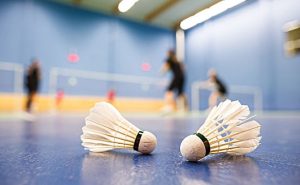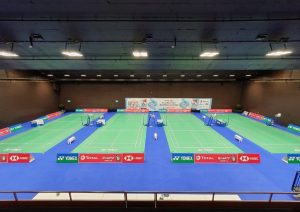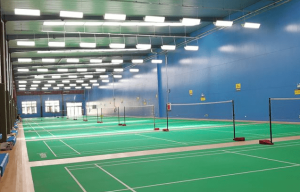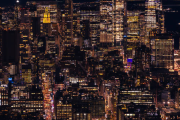Briefly Describe the Lighting Design of Indoor Badminton Court
1. Introduction
Sports carry the dream of national prosperity and national rejuvenation.
Only by accelerating the in-depth integration of the Internet, big data and sports real economy can we continue to create a new situation for the development of my country’s sports industry and build my country into a sports power.
As an important part of sports venues, badminton halls play an important role in promoting the development of the sports industry and promoting the transformation of regional industries. A professional badminton court should choose high-quality special lights for badminton court.
Regardless of whether your arena is at the level of entertainment training or professional competition, the lighting of the stadium should be uniform, soft and not dazzling, with clear vision and good color reproduction! This function is precisely what ordinary lights do not have.
So how to design the most practical lights for badminton courts? This article will take a standard indoor badminton court as an example to discuss the best design scheme.

2. Specifications of lights
The standard field of domestic badminton courts is a rectangular field with a length of 13.40m, a width of 6.10m for doubles and a width of 5.18 ms for singles.
Conventional lighting fixtures (metal halide lights, etc.) have concentrated and dazzling light, and the light is easily blocked by structures and other objects, resulting in limited lighting range; at the same time, the lights have high power and are easily damaged, and long-term use will cause serious power waste, and It is easy to cause safety hazards.
Sports experts are actively looking for new LED anti-glare lighting alternatives. After a multi-source comparison, the use of new LED energy-saving lights to replace conventional metal halide lighting has greatly improved the shortcomings of conventional lighting. The overall process is beautiful, the lighting effect is good, and Significant savings in construction electricity costs.
Under normal use conditions, the lighting LED energy-saving lights have a long life, with a theoretical lighting time of nearly 87,600 hours, which is 10 to 15 times that of traditional lights. Moreover, in the composition material of LED flexible light strip, whether it is LED or FPC, the material is made of environmentally friendly materials, which are recyclable and will not cause pollution and damage to the environment due to extensive use.
The successful replacement of LED energy-saving light strips has improved the quality of on-site lighting technology, reduced power waste, and reduced material loss, with significant economic benefits.
There are also requirements for the lighting contrast of badminton competition venues. Generally, T5 lights are used in venues, and the illumination should reach 1000 lux. If there is a TV broadcast venue, the illumination should be doubled to 1800 to 2000 lux.

3. Arrangement of lights
Indoor badminton hall lighting can be arranged in the following two ways.
- Vertical lighting on both sides: The lights are installed above the sidelines on both sides (lights should not be installed above the stadium area and the two end areas), and the lights are illuminated perpendicular to the ground. This method is widely used.
The luminaires are arranged above the site, and the beams are arranged perpendicular to the site plane.
Symmetrical light distribution lights should be selected for the top layout, which is suitable for badminton with high requirements on the uniformity of horizontal illumination on the ground and no TV broadcast requirements. It is suitable for sports lighting with anti-glare function.
This arrangement basically follows the arrangement of the roof, which is easy to install.
- Sparring the lights on both sides:the lights are arranged on both sides of the field, and the beam is not perpendicular to the field plane, which is suitable for stadiums with high space.
The lights are arranged on both sides of the site, and the beams are not perpendicular to the site plane.
Asymmetric light distribution lights should be used for the lights on both sides, which should be arranged on the horse track. It is suitable for stadiums with high vertical illuminance requirements and TV broadcast requirements. Glare can be reduced through angle control. When the lights are arranged on both sides, the aiming angle of the lights should not be greater than 65 degrees.
This arrangement is common in ordinary professional stadiums, and there are many cases where LedsMaster sports lighting is designed and arranged in such stadiums.
- Mix and distribute lights: It is a combination of top layout and two side layout. It is mainly to meet the requirements of high-definition broadcast of top events. The venue has a high space and is equipped with horse tracks or lifting trusses. Generally, two or more different light distribution lights are used, and mixed layout is common in professional Arenas and competition venues or large badminton events.
The lights should have the characteristics of instant start, accurate light distribution, and anti-glare devices. The lighting lights of LedsMaster Sports Lighting can meet such requirements!
The lights are generally four lights on one side, or 3-8 lights. The number of lights and light power can be selected according to different requirements.

4. Installation of lights
According to the regulations of international badminton competitions, the minimum space above the entire court is 9 ms. Within this height, there shall be no beams or other obstacles. International competitions require a minimum height of 12m and installation height of lights of at least 11.5m.
There should be no obstacles within 2 ms around the court. There should be a minimum distance of 2.1 ms between any two pitches side by side. The lighting requirements of the badminton court shall be arranged according to the size of the badminton court and the illumination requirements of the badminton court.
If the competition venue is open to the public when there is no competition arrangement, operating costs and management costs should also be considered. For example, the lighting settings should also consider factors such as power saving, cooling in summer, and individual lighting control for each venue. In order to reduce costs, the number of windows can be increased, and natural light can be used as a supplementary light source for lighting.
Indeed, professional badminton venues have stricter lighting requirements. In order to save costs, many arenas will choose to install lights by themselves, which requires a better understanding of the various hardware and software requirements of lighting. Therefore, I still recommend that friends in need seek professional help. Not only can LedsMaster customize lighting design solutions for the venue, but there are also many lights to choose from!
5. Conclusion
So now let’s review the most noteworthy issues in the lighting design scheme of a standard indoor badminton court:
First of all, the lights must be qualified, not flickering, not dazzling, and the lighting should be as soft as possible.
Secondly, the height of the installed lights is very important. If the lights are installed above the court, it is best to have a height of more than 10 ms, otherwise the badminton will be very easy to touch.
Another is the brightness problem, which should be consulted with the lighting provider, and the lighting should be distributed reasonably according to the size of the venue. There is no particularly bright place, nor can there be a particularly dark place, and it should be kept uniform. The illuminance requirement is greater than 300Lx, and the vertical illuminance is greater than half of the horizontal illuminance.
Now in general professional badminton courts, the lights are arranged at a height of four or five ms on both sides of the court, and the lights are generally dominated by fluorescent tubes. There are about 30 to 40 tubes on each side.
The uniformity of illumination is used to measure the visual conditions in the venue. Uniformity means that the venue should be irradiated evenly, and there should be no areas that are too bright or too dark, so as to provide good visual conditions for athletes, spectators, and referees.
For example, for television broadcasts, when the camera captures the panorama of the competition area, the illumination can not vary greatly, otherwise the camera will be exposed.
Badminton court lighting not only requires the beauty of the overall lighting, but also has different lighting requirements for different areas of different venues. The params, diversity and overall appearance effects of lighting products are strictly required, and certain product development strength and professional lighting solutions are required. design team.
This requires LED companies to have a good foundation in product diversification and lighting design. In 2019 to 2020, we launch the new series of solar powered flood light for tennis fields that save 75% to 90% energy, which is compatible to clay. indoor hard and outdoor grass tennis courts. Apart from choosing the lights, the photometric analysis & lighting design are the keys to success as well.






